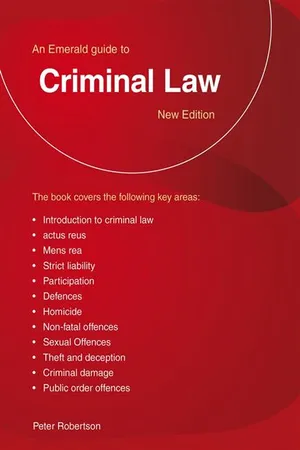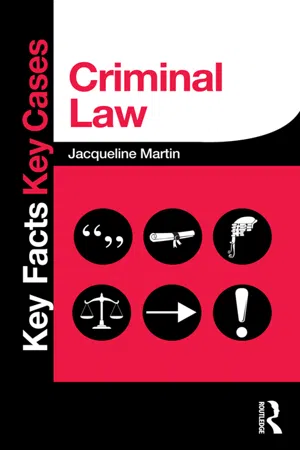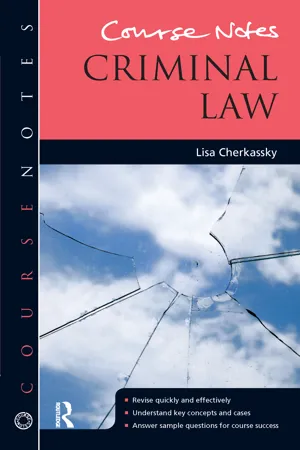Law
Absolute Bodily Harm (ABH)
Absolute Bodily Harm (ABH) refers to a serious injury that causes substantial harm to a person's physical health or appearance. In legal terms, it is a criminal offense that falls between common assault and grievous bodily harm. The severity of ABH is determined by the extent of the injury and its impact on the victim's well-being.
Written by Perlego with AI-assistance
Related key terms
1 of 5
3 Key excerpts on "Absolute Bodily Harm (ABH)"
- eBook - ePub
- (Author)
- 2013(Publication Date)
- Straightforward Publishing Digital(Publisher)
Section 47 of the Offences Against Persons Act 1861 covers actual bodily harm. The act does not define what constitutes actual bodily harm although case law has developed this. The offence is a triable either way offence and there is a maximum sentence of five-years if the case is tried in the Crown Court. If the magistrates agree and the defendant chooses a Magistrates Court trial then the case can be dealt with summarily.Actual bodily harm is a form of aggravated assault. Before it is decided that the victim has suffered harm then it is necessary to establish that he has been subject to either assault or batteryDefining actual bodily harm
In the case of Miller 1954, the term ‘actual bodily harm’ was said to include ‘any hurt or injury calculated to interfere with the health and comfort of the victim’. In the case of Chan-Fook 1994, the Court of Appeal stated that ‘actual bodily harm’“are three words in the English language which require no elaboration and in the ordinary course should not receive any. The word ‘harm’ is a synonym for ‘injury’. The word ‘actual’ indicates that the injury should not be so trivial as to be wholly insignificant....The body of the victim includes all parts of his body, including his organs, nervous system and brain. Bodily injury therefore may include injury to any of those parts of his body responsible for his mental and other faculties”.Malicious wounding or grievous bodily harm
Section 20 of the OAPA 1861 states that: ‘whosoever shall unlawfully and maliciously wound or inflict any grievous bodily harm upon any person, either with or without any weapon or instrument shall be guilty of an offence’. The maximum punishment for this offence is five years.Malicious wounding or grievous bodily harm is further defined under s18 of the OAPA 1861, which has been amended by the Criminal Law Act 1967. This section states: - eBook - ePub
- Jacqueline Martin(Author)
- 2014(Publication Date)
- Taylor & Francis(Publisher)
D and a group of other youths chased V. V fell to the ground and saw D coming towards him. V covered his head with his arms and was kicked. He momentarily lost consciousness and remembered nothing until being woken by a police officer. D was convicted of assault occasioning actual bodily harm.Key LawMomentary loss of consciousness could be actual bodily harm. ‘Harm’ was a synonym for injury. ‘Actual’ indicated that the injury should not be so trivial as to be wholly insignificant. Loss of consciousness fell within the meaning of actual bodily harm.11.2.1 Chan Fook [1994] 2 All ER 552, (1994) 99 Cr App R 147Key FactsD thought that V had stolen his fiancée’s ring. D dragged V upstairs and locked him in a second-floor room. V tried to escape but was injured when he fell to the ground. At D’s trial on a s 47 charge it was claimed that V had suffered trauma before the escape bid and that this amounted to ABH. The judge directed the jury that a hysterical or nervous condition was capable of being ABH. D was convicted, but the Court of Appeal quashed the conviction.Key LawPsychiatric injury is capable of amounting to actual bodily harm but ‘mere emotions such as fear, distress or panic’ do not amount to ABH.Key Judgment: Hobhouse LJ‘The body of the victim includes all parts of his body, including his organs, his nervous system and his brain. Bodily injury therefore may include injury to any of those parts of his body responsible for his mental and other faculties.’Key LinksIreland [1997] 4 All ER 225: see 11.1.Burstow [1997] 4 All ER 225: see 11.3.11.2.2 Savage [1991] 4 All ER 698, (1991) 94 Cr App R 193Key FactsD threw beer over another woman in a pub. In doing this the glass slipped from D’s hand and V’s hand was cut by the glass. D said that she had only intended to throw beer over the woman. D had not intended her to be injured, nor had she realised that there was a risk of injury. She was convicted of a s 20 offence but the Court of Appeal quashed that and substituted a conviction under s 47 (assault occasioning actual bodily harm). She appealed against this to the House of Lords. The Law Lords dismissed her appeal. - eBook - ePub
- Lisa Cherkassky(Author)
- 2013(Publication Date)
- Routledge(Publisher)
Mental element for battery will sufficeBrown (1993)Victims cannot consent to actual bodily harmCheckpoint - actual bodily harmActual bodily harm Case: Rule: Attorney-G’s Ref (No. 6 of 1980) (1981)Exceptions exist in law (e.g. surgery & sport) Barnes (2005)Sporting exceptions Jones (1986)Mistaken belief in consent is relevant 9.4 Malicious WoundingItem on checklist:Done!I can cite the statutory location of the criminal offence of actual bodily harm I can describe the actus reus of actual bodily harm using three legal authorities as supportI can describe the mens rea of actual bodily harm in light of Savage (1991)I understand that the line of consent drawn in Brown (1993) means that a victim cannot consent to an actual bodily harmI can explain the sporting exception under Barnes (2005)- Moderately serious injuries are charged under s.20 of the Offences Against the Person Act 1861.
- This offence is commonly known as ‘malicious wounding’ and is triable either way with a maximum of five years in jail.
Workpoint
Below is the statutory definition of malicious wounding. What are the key words in the definition, including what you believe are the actus reus and mens rea
Index pages curate the most relevant extracts from our library of academic textbooks. They’ve been created using an in-house natural language model (NLM), each adding context and meaning to key research topics.


